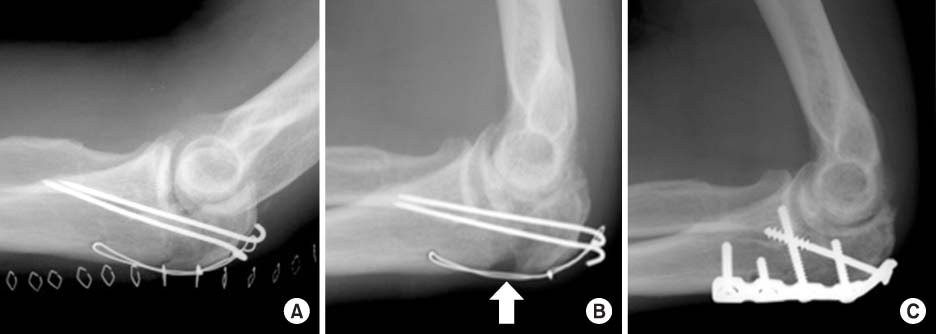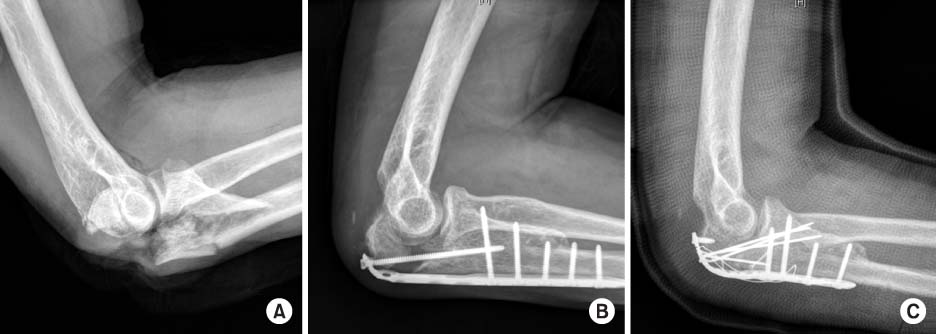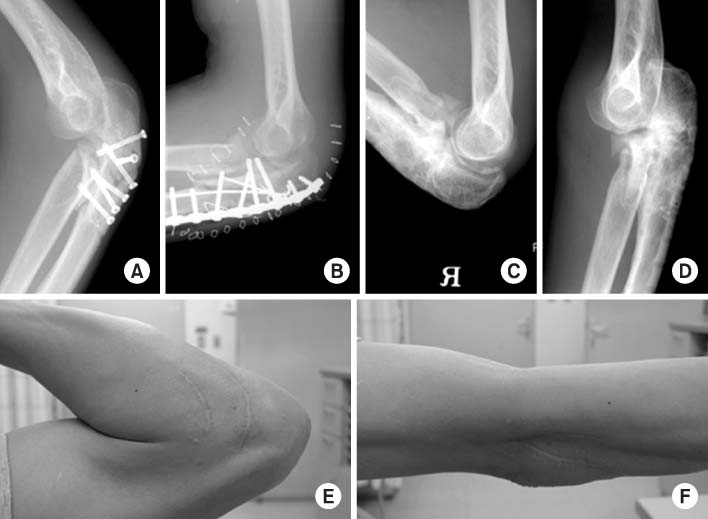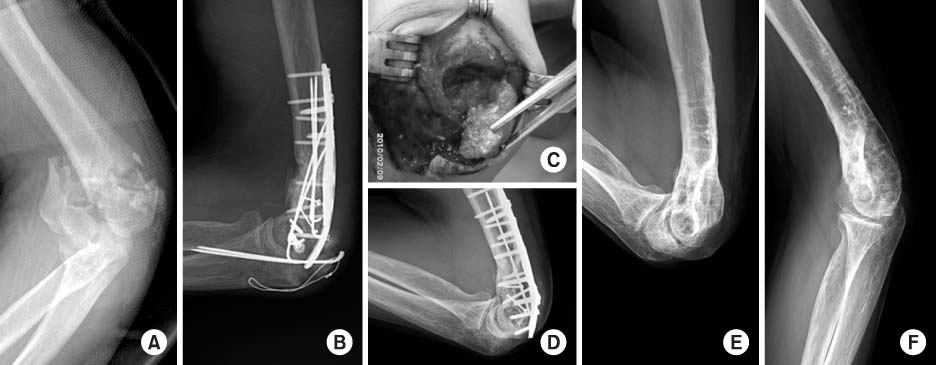J Korean Fract Soc.
2015 Jan;28(1):30-37. 10.12671/jkfs.2015.28.1.30.
Olecranon Nonunion after Operative Treatment of Fracture
- Affiliations
-
- 1Department of Orthopedic Surgery, Yonsei University College of Medicine, Seoul, Korea. kkimjsno1@naver.com
- KMID: 1774094
- DOI: http://doi.org/10.12671/jkfs.2015.28.1.30
Abstract
- PURPOSE
Olecranon nonunion after surgical management is relatively rare, but it leads to limitation of motion of joint or instability. This retrospective study was conducted in order to analyze the cause and result of treatment.
MATERIALS AND METHODS
We analyzed 11 cases treated for nonunion of olecranon fractures. Nonunion was classified according to the spot of the lesion and the extent of articular surface damage. Evaluation was performed using Mayo elbow performance score (MEPS), Oxford elbow score (OES), Disabilities of the Arm, Shoulder and Hand (DASH) scores, and the range of motion.
RESULTS
According to the spot of the lesion and the extent of articular surface damage, nonunion was categorized as IA (2 cases), IIA (5 cases), and IIIA (4 cases). One case of IA underwent nonunion fragment excision and the remaining cases were treated by bone grafting. A plate was used in seven cases and the other three cases had both plate and tension band wiring fixation. All nonunions finally became union. The 11 patients with one year follow-up had average MEPS of 87.7 points (range: 60-100 points), average OES of 43.2, and average DASH score of 18.8 points. Complications included limitation of motion (2 cases) and ulnar nerve symptoms (3 cases).
CONCLUSION
Bone grafting and fixation by plate may be beneficial. In addition, excision can be useful in type I.
MeSH Terms
Figure
Reference
-
1. Helm RH, Hornby R, Miller SW. The complications of surgical treatment of displaced fractures of the olecranon. Injury. 1987; 18:48–50.
Article2. Horne JG, Tanzer TL. Olecranon fractures: a review of 100 cases. J Trauma. 1981; 21:469–472.3. Jensen CM, Olsen BB. Drawbacks of traction-absorbing wiring (TAW) in displaced fractures of the olecranon. Injury. 1986; 17:174–175.
Article4. Macko D, Szabo RM. Complications of tension-band wiring of olecranon fractures. J Bone Joint Surg Am. 1985; 67:1396–1401.
Article5. Murphy DF, Greene WB, Dameron TB Jr. Displaced olecranon fractures in adults. Clinical evaluation. Clin Orthop Relat Res. 1987; (224):215–223.
Article6. Rettig AC, Waugh TR, Evanski PM. Fracture of the olecranon: a problem of management. J Trauma. 1979; 19:23–28.7. Wolfgang G, Burke F, Bush D, et al. Surgical treatment of displaced olecranon fractures by tension band wiring technique. Clin Orthop Relat Res. 1987; (224):192–204.
Article8. Papagelopoulos PJ, Morrey BF. Treatment of nonunion of olecranon fractures. J Bone Joint Surg Br. 1994; 76:627–635.
Article9. Eriksson E, Sahlin O, Sandahl U. Late results of conservative and surgical treatment of fracture of the olecranon. Acta Chir Scand. 1957; 113:153–166.10. Veillette CJ, Steinmann SP. Olecranon fractures. Orthop Clin North Am. 2008; 39:229–236.
Article11. Kang S, Hwang CS, Chung PH, Kim YS, Chung JW, Kim JP. Double tension band wiring for olecranon fractures. J Korean Fract Soc. 2008; 21:130–134.
Article12. Kang HJ, Lee WY, Kim HS, Koh IH, Choi YR, Lee JJ. Fixation of olecranon fractures using plating system. J Korean Soc Surg Hand. 2012; 17:29–36.13. Rotini R, Antonioli D, Marinelli A, Katusić D. Surgical treatment of proximal ulna nonunion. Chir Organi Mov. 2008; 91:65–70.
Article14. Danziger MB, Healy WL. Operative treatment of olecranon nonunion. J Orthop Trauma. 1992; 6:290–293.
Article
- Full Text Links
- Actions
-
Cited
- CITED
-
- Close
- Share
- Similar articles
-
- Clinical Observation of the Olecranon Fracture
- Tension Band Fixation in the Treatment of the Olecranon Fracture
- Etiology and Management of Nonunion
- Nonunion of a Stress Fracture Through the Olecranon Epiphyseal Plate in an Adolescent Judo Player: A Case Report
- The Result of the Tension Band Internal Fixation






